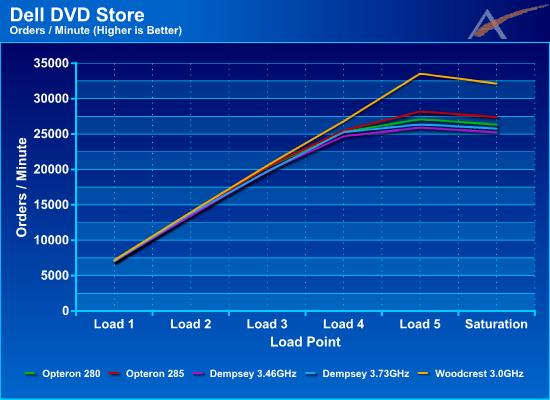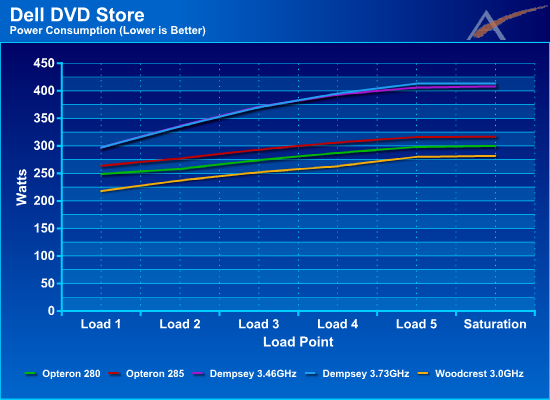Intel Woodcrest: the Birth of a New King
by Jason Clark & Ross Whitehead on July 13, 2006 12:05 AM EST- Posted in
- IT Computing
Dell Test results

At the first three load points all platforms are within 4% of each other. At the fourth load point the spread opens up and Woodcrest leads the Opteron 285 by 5% and Dempsey 3.73 by 6%. Finally, at the fifth load point, Woodcrest is able to lead the Opteron 285 by 19% and Dempsey 3.73 by 27%. It is interesting to note in this graph, and other upcoming performance graphs, that Woodcrest scales linearly to the fifth load point but the others stop scaling linearly between the third and fourth load points.

Woodcrest is clearly the lowest consumer of power and leads the Opteron 285 by 11%-17%, and Dempsey 3.73 by 27%-33%. FB-DIMMs do consume more power than regular DDR2 memory, which partially offsets some of the advantage of the Core architecture.

When we combine performance and power and come up with Performance/Watt we get a very different picture. In this graph we see that Woodcrest is the clear leader at all load points and leads the Opteron 285 by 17% - 34%, and Dempsey 3.73 by 39%-88%. It is also interesting to note that the Opteron 280 outperforms the Opteron 285 on a Performance/Watt measure while Dempsey performance scales almost linearly with power. This often is an indication that the architecture is reaching its clockspeed limits, which is certainly the case as the only faster dual core K8-based chip presently available is the FX-62.

At the first three load points all platforms are within 4% of each other. At the fourth load point the spread opens up and Woodcrest leads the Opteron 285 by 5% and Dempsey 3.73 by 6%. Finally, at the fifth load point, Woodcrest is able to lead the Opteron 285 by 19% and Dempsey 3.73 by 27%. It is interesting to note in this graph, and other upcoming performance graphs, that Woodcrest scales linearly to the fifth load point but the others stop scaling linearly between the third and fourth load points.

Woodcrest is clearly the lowest consumer of power and leads the Opteron 285 by 11%-17%, and Dempsey 3.73 by 27%-33%. FB-DIMMs do consume more power than regular DDR2 memory, which partially offsets some of the advantage of the Core architecture.

When we combine performance and power and come up with Performance/Watt we get a very different picture. In this graph we see that Woodcrest is the clear leader at all load points and leads the Opteron 285 by 17% - 34%, and Dempsey 3.73 by 39%-88%. It is also interesting to note that the Opteron 280 outperforms the Opteron 285 on a Performance/Watt measure while Dempsey performance scales almost linearly with power. This often is an indication that the architecture is reaching its clockspeed limits, which is certainly the case as the only faster dual core K8-based chip presently available is the FX-62.










59 Comments
View All Comments
peternelson - Thursday, July 13, 2006 - link
Agreed!I'm not interested in 32 bit performance.
If you're gonna be spending this much money on an upmarket system you better be running it in 64 bit mode. I know I will.
So if Opteron benches better than Woodcrest in 64 bit mode that changes the equation for me.
Also isn't Opteron 290 out any time now? The would close the % gap a little because of the higher clock speed.
Also S1207 Opterons will be here 1st August. The new nforce5 based pro/server chipsets might give a little boost over existing ones too, as could the bandwidth boost and lower power of DDR2.
defter - Thursday, July 13, 2006 - link
Check the review, this (and previous Linux review) uses only 64bit software.
Kiijibari - Thursday, July 13, 2006 - link
Oh indeed, x64 Windows was used.Good to see than, that woodcrest doesnt take a 64bit penalty. Maybe the Linux application of my source uses FP calculations and no SSE, or it is due to the compiler which may be in favour for Intel on the windows. Anyways 64bit is a big "playing" field for benchmarks looking forward to read more ;-)
cheers
Kiijibari
Calin - Thursday, July 13, 2006 - link
Slightly better performance and slightly lower power consumption. Looks like you have a winner for new servers.However, for a Fortune 500 company, there are other things much more important than slightly better performance and slightly lower power consumption.
JarredWalton - Thursday, July 13, 2006 - link
After the poor showing of NetBurst Xeons against Opteron, I'd think any Dell shops would be thrilled to regain the performance crown. Also, frankly, a 5-10% lead is about all most things get you these days, especially when I/O and everything else comes into play. The Woodcrest systems have better overall CPU performance, but it often isn't that important when working on massive databases.Incidentally, from what we've seen of Conroe, it seems like Intel could release Core chips at up to 3.4-3.6 GHz without difficulty right now. Rather surprising, given the 14 stage pipeline vs. 39 for Prescott.
FesterOZ - Thursday, July 13, 2006 - link
Actually its not a big thrill at all. One of the major pushes at the firm is to consolidate into VMware based servers or larger raw servers but in all cases stop the traditional 1 server per application that seems to affect most firms. Therefore we are more focused on 4 socket 8 core style servers i.e. HP BL45 blades than 2 socket blades. We had all the top level Dell executives coming in trying to convince us to stay with Dell because at this time, they have no answer for the larger server (the Oct/Nov timeframe for the Dell 4 socket AMD server is too far out). So in the short term we will be a hybrid Dell/HP shop. Maybe we will shift back if Dell's commitment to AMD indeed ramps as expected.Dubb - Thursday, July 13, 2006 - link
I doubt this has much practical use, but I am nonetheless curious...could you "pinmod" a cloverton to run 1333 FSB?might make for some speedy rendering if it was stable.
Kiijibari - Thursday, July 13, 2006 - link
No that is not possible, dont you think that intel would release it, if it would be possible ? Just think about it, to lower the FSB bandwidth on the 4core part doesnt make sense, does it ? 4 cores are much more bandwith hungry than 2 ..Reason is the "Intel bolt-together" architecture. The 4core part is just 2 Dies in one package, thus it will have twice the bus load of a single (dual core) CPU. Intel did the same already with Netburst dual cores, hence you have the same FSB limitations there.
All in all it is a little bit odd, Cloverton/Kentsfield performance increases will be much less than linear, but Intel has the advantage of time to market vs. the AMD K8L quad core. Though AMD's QC design looks much more sound I expect intel to be 1st with releasing a quad core CPU.
cheers
Kiijibari
Dubb - Thursday, July 13, 2006 - link
okaaaayyy...cloverton's platform supports 1333, and the kentsfield ESs run 1333 easily. most clovertons probably CAN, it's just a question of if the 1066>1333 pinmod some have suggested for dempsey or 1066 woodcrests actually works, and if so, clovertons might be an interesting application of it.
I'm just curious, is'all.
Kiijibari - Thursday, July 13, 2006 - link
It may work, however that kind of overclocking is more dangerous than normal overclocking. It is easy to oc a chip that run at, lets say 2 GHz, and there is e.g. a 3 GHz top model. Chances are good that yields are well, thus your 2 GHz model may be able to run faster as most models pass 2.6 GHz tests, thus your model was just down binned to 2 GHz.However with the FSB1066 vs. FSB1333 I assume that you are playing around at the absolutly maximum. Intel would do everything to raise FSB speeds, exspecially with Quad cores. It is nonsense from the performance point of view, to decrease the available bandwidth while the number of bandwidth consumers (i.e. cores) increases.
It might boot & work with a FSB1333 though, but Intel cant and wont gurantee that. It may be good enough for Super Pi or other "fun stuff", but if you run I/O intensive applications, cross your fingers and be prepared for data corruption.
bb
Alex